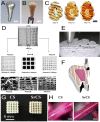Bioprinting and biomaterials for dental alveolar tissue regeneration
- PMID: 37122863
- PMCID: PMC10140526
- DOI: 10.3389/fbioe.2023.991821
Bioprinting and biomaterials for dental alveolar tissue regeneration
Abstract
Three dimensional (3D) bioprinting is a powerful tool, that was recently applied to tissue engineering. This technique allows the precise deposition of cells encapsulated in supportive bioinks to fabricate complex scaffolds, which are used to repair targeted tissues. Here, we review the recent developments in the application of 3D bioprinting to dental tissue engineering. These tissues, including teeth, periodontal ligament, alveolar bones, and dental pulp, present cell types and mechanical properties with great heterogeneity, which is challenging to reproduce in vitro. After highlighting the different bioprinting methods used in regenerative dentistry, we reviewed the great variety of bioink formulations and their effects on cells, which have been established to support the development of these tissues. We discussed the different advances achieved in the fabrication of each dental tissue to provide an overview of the current state of the methods. We conclude with the remaining challenges and future needs.
Keywords: bioink; biomaterials; bioprinting; dental tissue engineering; dentistry.
Copyright © 2023 Ostrovidov, Ramalingam, Bae, Orive, Fujie, Shi and Kaji.
Conflict of interest statement
The authors declare that the research was conducted in the absence of any commercial or financial relationships that could be construed as a potential conflict of interest.
Figures



References
Publication types
LinkOut - more resources
Full Text Sources

